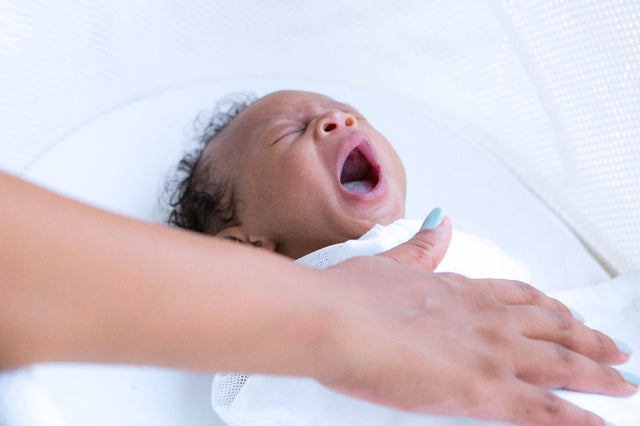Wake-and-Sleep: Teaching Babies to Sleep on Their Own

Surprise: Sleep training isn’t about getting your baby to sleep through the night. The truth is no baby…no child…no adult EVER sleeps through the night! Yup! You read that right! We all rouse at least a tiny bit three to four times a night. In fact, newborns have lightning-fast sleep cycles, which means they return to very light—easily disturbed—sleep about every 45 to 60 minutes, making them vulnerable to wakeups throughout the night. So, your sleep-training goal is not really about getting your baby to sleep through the night, but to help them learn how to self-soothe when they inevitably wake up in the middle of the night and need to get back to sleep. Good to know, right? But it’s even better to know how to teach your little one how to do it! Here’s help.
Rethink infant sleep training.
What is sleep training, anyway? Sleep training is often used synonymously with the “cry it out,” but that’s not accurate. There are plenty of sleep training methods out there. The “cry it out” sleep training method is just one of them. But in the end, all sleep training methods are about the same thing: teaching your baby that they’re capable of falling asleep independently. Learning to self-soothe in the middle of the night will not only help your little one get more sleep, but you as well.
What’s the right age for sleep training?
Sleep training should start based on your baby’s development. This usually means that babies are ready for traditional sleep training between 4 and 6 months old, before they’ve had time to get too used to rocking or nursing to sleep. The big exception to this rule: If you use the wake-and-sleep method, you can start sleep training whenever you like!
Teach your baby how to self-soothe.
As tempting as it is to rock your baby to sleep in your arms and stealthily slide them into their bassinet, doing that every night makes your little one reliant on your help during those little middle-of-the-night wake-ups. Of course, you can still enjoy letting your baby sleep in your arms, but I suggest you also help your baby develop the skills they need to fall asleep on their own, because, frankly, they can!
So...how do you teach a baby to self-soothe? Training your baby to self-soothe and sleep through the night is made possible with something called the wake-and-sleep method. Here’s how to “sleep train” your infant using this gentle sleep training method:
-
Step 1: Every evening at bedtime, swaddle your little one and turn on some rough and rumbly white noise, making it as loud as a shower. Swaddling and white noise are two important elements of the 5 S’s for soothing babies. They work to activate Baby’s innate calming reflex, which is like an “off switch” for fussing and an “on switch” for sleep.
-
Step 2: Feed and burp your swaddled baby and consider adding another of the 5 S’s to the mix: Sucking. Offer Baby a pacifier post-feed (once breastfeeding has been well-established if nursing) as it’s a proven baby-calmer. Soon, your baby will fall asleep in your arms.
-
Step 3: Once off to dreamland, lay your baby down in their bassinet—safely on their back.
-
Step 4: Right after you slide your munchkin into their bassinet, softly tickle Baby’s neck or feet to gently rouse them until their eyes just barely open.
-
Step 5: After a few seconds, your little one will close their eyes again and drift off to sleep.
As long as your precious baby is swaddled and shushed—and their tummy is filled with milk—they should be able to fall back to sleep quickly…with little crying. If they resist falling back to sleep, simply crank up the white noise and jiggle the bassinet for a few seconds to help your bub along. But if the crying persists, pick your baby up to feed or soothe them to sleep…and then gently wake Baby again when you place them back down.
I know this sounds ludicrous, but believe me: You should always wake a sleeping baby! Those few seconds of drowsy waking—without being held or nursed—are your little one’s first steps to learning how to self-soothe and sleep through the night! (By the way, this “sleep training” method is a great complement to dream feeding.)
SNOO teaches self-soothing, too!
Just like the wake-and-sleep method, SNOO, my responsive bassinet, helps babies figure out how to self-soothe. Here’s how: When your baby was in the womb, they experienced near-constant rocking and soothing sounds. SNOO copy-cats those sensations that naturally activate your baby’s calming reflex, helping your little one not only fall asleep, but easily drift from one sleep cycle to the next—often without fully waking. If your baby does wake and fuss during those sleep transitions, SNOO pauses just enough before increasing to the next level of soothing to allow your baby the opportunity to start learning how to get back to sleep on their own. And, because SNOO responds just-quick-enough to cries, it may also help your baby build a sense of trust (also known as “attachment”). This, in turn, boosts your little one’s confidence to fall asleep independently!
Finally, did you know that Happiest Baby’s SNOO Smart Sleeper was actually developed using the same scientific principles from the wake-and-sleep method? It’s true! Between 4 and 6 months, SNOO gradually weans your baby off motion, training them to sleep independently and make an easy transfer to a crib.
For more tips to help babies sleep better, check out…
- What to Do When Your Baby Won't Sleep in a Bassinet
- How Much Do Babies Sleep?
- What are Wake Windows?
- Baby Only Sleeps in Your Arms...Now What?
- Help! My Baby Hates the Swaddle!
Have questions about a Happiest Baby product? Our consultants would be happy to help! Submit your questions here.